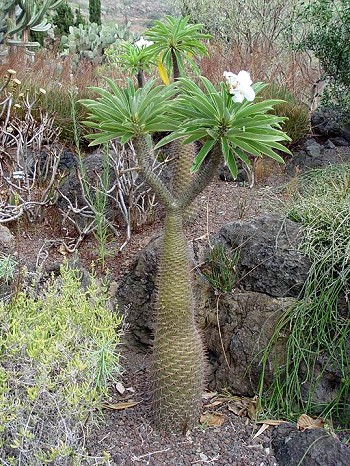
|
|
Pachypodium
lamrei (Madagascar Palm)
|
Pachypodium -
Pachypodium spp.
Pachypodium is a genus of succulent spine-bearing trees and shrubs, native to
Africa. It is a genus of about 20 to 24 species and belongs to the large family,
Apocynaceae. Like all species in this family - Pachypodium's sap is poisonous to
stock/human. Pachypodium comes from Greek pachy (thick) and podium (foot), hence meaning
thick-footed, referring to the thickened stem or caudex.
The majority are from Madagascar with some from southern
Africa.
The usually bottle-shaped trunk is usually solitary and wide, they range from small
(eg P. brevicaule), to six to ten metres tall 'trees' (eg P. lamerii and P.
geayi) and armed with stout paired spines and topped with a rosette of long leaves
(sort of palm-like ... hence the common name 'Madagascar Palm' for some species).
They flower on mature plants, that might be 10 years or more from seed, and like most members of the Apocynaceae family they are large and
showy.
Genus characteristics
All Pachypodium are succulent plants that exhibit, to varying degrees, the morphological characteristics of pachycaule trunks and
spinescence. These are the most general features of the genus and can be considered distinguishing
characteristics.
The pachycaule trunk is a morphologically enlarged trunk that stores water so as to survive seasonal drought or intermittent periods of root desiccation in
exposed, dry, and rocky conditions. Whereas there is great variation in the habit of the plant
body, all Pachypodium exhibit pachycaul growth. Variation in habit can range from dwarf flattened plants to bottle shaped shrubs to
dendroid-shaped trees.
The second general characteristic of Pachypodium is spinescence, or having
spines. The spines come clustered in either pairs or triplets with these clusters often arranged in rings or whorls around the
trunk. Spines emerge with leaves, and like leaves grow for a short period before stopping growth and
hardening. Spines do not regenerate so weathering and abrasion can wear away all but the youngest spines from older specimens - leaving smooth trunks and
branches.
To some extent, branches are a characteristic of the genus. Some caution is warranted in
over-generalizing this characteristic. Pachypodium namaquanum is often
branchless. Pachypodium brevicaule has no clear branches, and indeed may have evolved an alternative to branching in the form of nodes from which
leaves, spines, and inflorescences emerge. In general Pachypodium have few
branches. Since the environmental stresses and factors that contribute to branching can vary widely even in small
areas, individual plants of the same species exhibit wide variation in branching
morphology.
Unlike many members of the Apocynaceae, including some members of the superficially similar
Adenium, Pachypodium species do not exude a milky latex. Rather, the sap is always
clear.
Madagascar Palm (Pachypodium lamerei) is a species of Pachypodium. It has large thorns and leaves mostly just at the top of the
plant. It is a stem succulent and comes from the island Madagascar. The plant bears
large, fragrant flowers. The species has become one of the best known pachypodiums in
cultivation, being relatively easy to propagate and grow. In cultivation it is often marketed as the
"Madagascar Palm", despite in not being a palm at all. A variety called
"Ramosum" has been described. It is distinguished mostly by a dwarf growth
habit.
Pachypodium lamerei has a tall, silvery-gray trunk covered with sharp 6.25 cm
spines. Long, narrow leaves grow only at the top of the trunk, like a palm tree. It rarely
branches. Although plants grown outdoors will reach up to 6 m, when grown
indoors, it will slowly reach 1.2-1.8 m tall.
Plants grown outdoors will develop large, white, fragrant flowers at the top of the
plant. However, it rarely flowers indoors.
Source:
http://en.wikipedia.org/wiki/Pachypodium
http://en.wikipedia.org/wiki/Pachypodium_lamerei
http://pachypodium.net/
http://www.cssnz.org/pachypodium-and-caudiciforms.php
